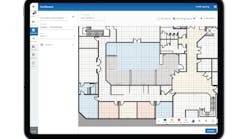Ingy, smart lighting’s newest startup, launches with a two-step plan for commercial users.
In the lighting industry’s long, meandering, pothole-filled road toward becoming a smart building industry, big players such as GE and Osram have been known to change tack as they try to figure out exactly what their role is. Now, a much anticipated startup has also switched course.
Privately held, Amsterdam-based Ingy will not position itself after all as a matchmaker putting together smart lighting vendors with building owners and operators. That was its original intention when CEO Bastiaan de Groot co-founded the company less than a year ago.
But a funny thing happened on Ingy’s way to the market. It decided that there would be a greater opportunity in developing a proprietary wireless lighting control system that it claims greatly improves the installation, commissioning, and operation of office luminaires, and which also makes those luminaires ready to become smart building nodes delivering data for facilities management uses, including space optimization, asset tracking, and indoor navigation.
Ingy has developed its own occupancy sensors and has teamed with Holland’s Koopman Interlight as its first luminaire partner. The partnership enables commercial end users to commission and operate thousands of luminaires at a time using a tablet or smartphone. Users can program banks of lights or individual lights into different schemes. The programmed lights automatically adjust based on triggers from the sensors, which can reside either inside or outside the luminaires.
The hardware and software, including wireless wall switches, are available for a straight product fee from Interlight and from future luminaire partners.
Ingy boss Bastiaan de Groot sees too much data-related greed in the lighting industry, and has a new plan for using luminaires to collect and distribute information. (Photo credit: Mark Halper.)
In addition, Ingy is offering a service for end users who want to take the applications beyond lighting, and leverage the sensors for facility management purposes. For those uses, Ingy is partnering with building management portal providers, delivering data about room occupancy to the portal. It has signed at least two portal partners, one of which is Gooee, a smart lighting specialist that itself has gone through a number of mission statement changes, and which now declares data analytics as its raison d’être, focused on buildings. Ingy will announce other portal partners soon.
Leaving the middle
Both the lighting controls product business and the Internet-connected data analytics service mark a decided shift from Ingy’s original plan to play a consulting and middleman role. The idea had been to help establish lighting companies as lead players in smart building jobs by hooking them up with the many other disciplines typically involved, such as real estate and property management, information technology, and building automation.
“There is definitely a demand for a consulting firm that understands smart lighting and controls, and that can help companies there,” co-founder de Groot told LEDs Magazine. “But the more we started doing projects, we really saw the need for this solution. We said it’s far more attractive to actually go into the market with a solution with our own IP and become more of a product company.”
De Groot said Ingy spotted the opportunity because existing products fell short of what Ingy was trying to facilitate. Conventional DALI (digital addressable lighting interface) controls require too much costly wiring. And, anyway, he noted, the majority of the controls market is currently served by standalone sensors.
“We wanted to deliver a solution that could be sold at the same price point as a standalone non-connected sensor today, yet provide customers with a full upgrade path towards a smart-building,” de Groot said. “We make it very simple for our customers: Take your current design based on standalone sensors and replace them with our sensor hardware. Your budget does not need to be adjusted at all, yet you get a whole wealth of additional functionality. You can program your sensors super easy through our app, you get the full connected functionality normally requiring a full central DALI system, and you have all the hardware infrastructure in place to make your building smart.”
And according to de Groot, standardized wireless technologies such as Bluetooth and Zigbee cannot scale up lighting systems the way Ingy’s proprietary wireless mesh technology can.
“We can scale to thousands, even tens of thousands of nodes in one network, without a gateway being present,” he said. “And the system is fully self-configuring, so we do not need to tell any of the nodes which nodes need to relay the signal. It all adjusts itself fully automatically based on circumstances, based on network traffic.”
Greedy data plays
Notably, when Ingy collects data for facility management services, it is handing off the analysis of that data to another party, such as Gooee, rather than providing the cloud data analytics itself.
“We believe the lighting industry became greedy, claiming that they will own the data and become the party to visualize the data for the customer,” de Groot noted. “This is thinking from your interests and not that of the customer.”
Ingy has plenty of company among industry players who have significantly modified their smart lighting strategy. Its portal partner, Gooee, for instance, is now focusing data analytics for building management, even if it still offers smart lighting chipsets and sensors — some of which would compete against Ingy in that capacity.
It’s not just startups that have been fiddling with their smart lighting strategies. Large lighting companies have also been prone to vicissitudes. Osram, which is possibly up for sale, recently overhauled its approach to indoor positioning technology as its CEO Olaf Berlien fine-tunes the rhetoric around rebranding the company as a “high-tech photonics” organization. And GE began paring back the mission of its overarching Current smart lighting, building, and energy group almost immediately after launching it in 2015, eventually agreeing to sell the winnowed-down group to American Industrial Partners in a sale that closed yesterday.
Elusive IoT
One thing hasn’t changed: The smart, Internet of Things (IoT) lighting market has been slow to develop.
“It always takes longer than you think,” de Groot said. “But it’s really happening now.”
One of the issues holding it back has been that customers are uncertain about exactly what a smart building should do.
With that in mind, de Groot noted that Ingy’s lighting technology can provide the option to easily upgrade to “smart” once the end user decides what smart functions they want.
“We talk to customers who say, ‘We want our building to be smart.’ We ask them what that means, and they say, ‘To be honest, I have no idea.’” An Ingy lighting system will provide flexible, wireless lighting controls up front, while at the same time “providing the opportunity to make your building smart if at some point you decide you want to roll out asset tracking or occupancy analytics or any of the many other propositions we offer.”
Another issue that the lighting industry faces is that smart building customers might not want to make lighting the backbone of their smart building system, but might instead want to mount sensors and wireless chips independent of the lighting system. De Groot noted that a lighting-based smart building system provides a huge advantage in that it inherently provides a much wider coverage of building space.
“Lighting is everywhere,” de Groot said. “Lights can be placed into any part of the building. We increasingly see that people like the coverage of the lighting network.” He added that with the Ingy mesh network, “every light point can transmit data, we have coverage in every little corner of the room.” And in instances where users chose the sensor-embedded luminaires, they gain the advantage of powering the sensors with electricity rather than with problematic batteries.
Ingy will soon announce its first customer, a university medical center.
And Ingy is also investigating new uses for its smart technology. For example, it might soon offer bed-bug detectors for use in hotels.
It’s all part of the company’s redefined mission, to develop and expand smart lighting controls and services.
“This is real product development, which is what we wanted to shy away from initially,” said de Groot. “But we saw the opportunity and we grabbed it.”
MARK HALPERis a contributing editor for LEDs Magazine, and an energy, technology, and business journalist ([email protected]).
*Updated Apr. 5, 2019 12:48 PM for elaborative comments by Bastiaan de Groot.







